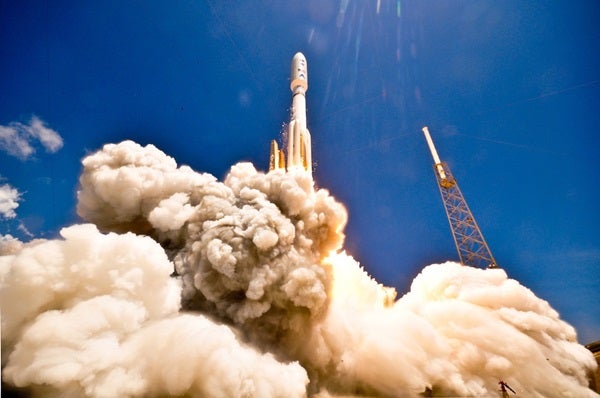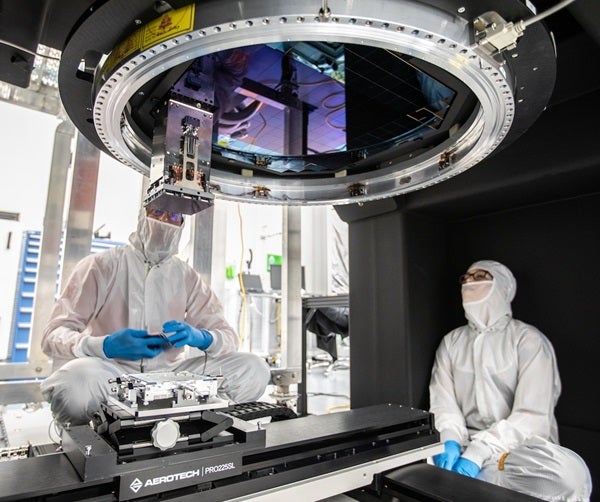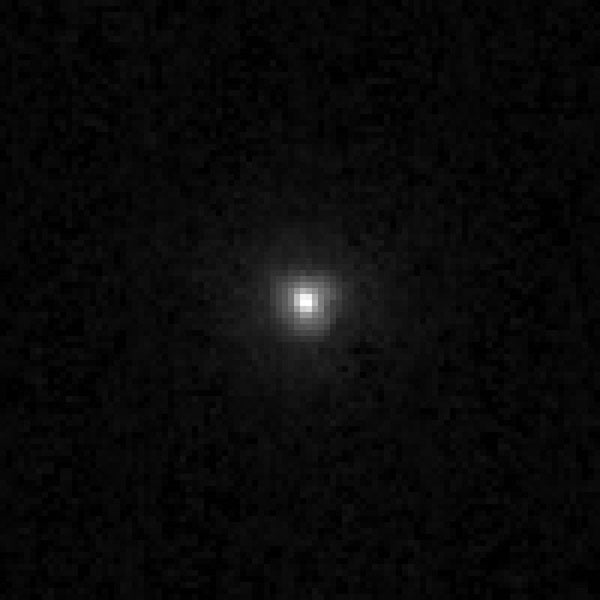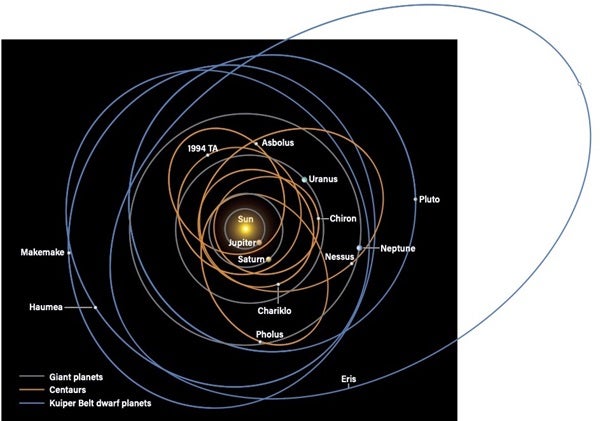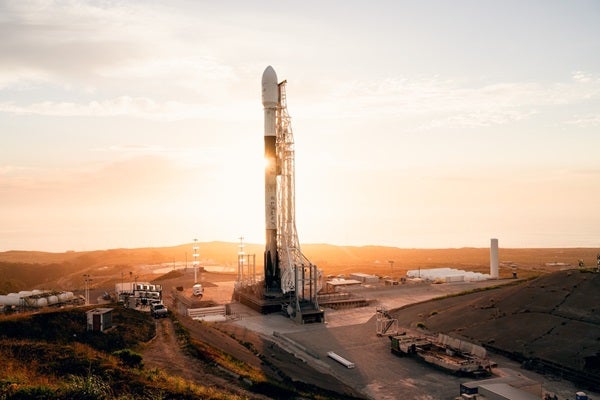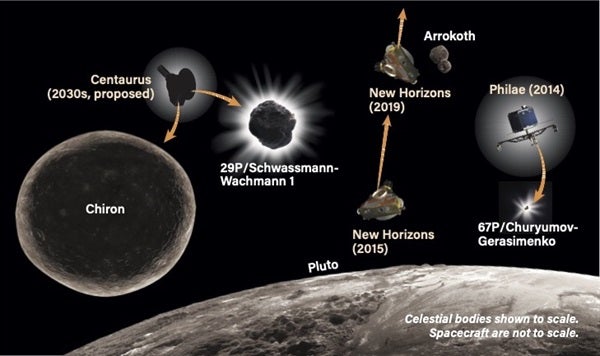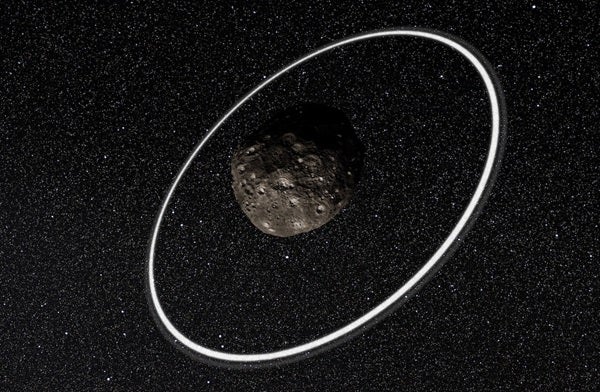22 October 2038:
After a journey of over a billion miles to the outer solar system, the Centaurus spacecraft is on final approach. Dead ahead lies Chiron, a mini-planet orbiting between Uranus and Saturn.
A native of the Kuiper Belt formed over 4 billion years ago, Chiron was recently (at least in astronomical terms) gravitationally dislodged from there and tossed into its current closer climes. Exploring it is now much easier than if it were still in the Kuiper Belt, over three times farther away.
And what a scientifically mouthwatering prize Chiron is. Known to have rings, an atmosphere, and surface activity, Chiron is also a world that lies in the critical size gap between planetesimals (the formation seeds of planets) and full-fledged planets, like Pluto.
Centaurus crossed that billion miles from Earth to Chiron to make the first reconnaissance of this amazing outer solar system world. Once all the precious images and spectra are collected to turn Chiron from a point of light into a real place, Centaurus will transmit them back to its international science team, the most diverse ever assembled for any solar system mission.
What lies ahead for Centaurus on final approach to Chiron? Raw exploration, fundamental discoveries, and the honor of being the first to visit the last large unexplored population of bodies this side of the Oort Cloud: the Centaurs, of which Chiron was the first discovered and is the best known.
Meet the Centaurs
When Clyde Tombaugh of Lowell Observatory detected Pluto in 1930, it was thought to be a lonely body orbiting in an empty region beyond Neptune. But with the discovery of the Kuiper Belt in the 1990s, it became clear that Pluto had in fact been a harbinger of the vast population of planets and planetesimals orbiting in this region.
However, a strong clue to the existence of the Kuiper Belt came nearly 15 years before the first Kuiper Belt object (KBO) discovery in 1992. That clue was the discovery of an object named Chiron in 1977 by American astronomer Charlie Kowal of the Carnegie Institution.
When Kowal first spotted Chiron, it was initially designated as an asteroid with the number 2060. But Chiron quickly became an enigma because nothing like it had ever been seen — a solid body over a hundred miles (161 kilometers) across, orbiting not within the asteroid belt beyond Mars, but among the giant planets. Some thought it was the core of a giant comet. Others conjectured it was an asteroid that had escaped from the main belt.
It soon became clear that Chiron was neither. Instead, it became the first known member of a new class of solar system bodies named Centaurs, which mostly orbit between Jupiter and Neptune.
Today we know of hundreds of Centaurs, and we know their provenance: They are a population of recently dislodged KBOs that must be constantly resupplied from the Kuiper Belt. Why the need to be resupplied? Because the orbits of Centaurs cannot persist for long — the strong gravitational tugs of the giant planets disturb their orbits, eventually setting them either on a collision course to impact one of the planets or on an escape path ejecting them from the solar system entirely. Thus, they’re lost from the Centaur population within a few million years — an astronomical blink of an eye.
Because these Kuiper Belt refugees lie so much closer to Earth than to the Kuiper Belt itself, they are brighter and bigger in our telescopes and therefore easier to study. In recent decades, we have learned that the Centaurs are a surprisingly diverse population, with members ranging from merely miles across to the sizes of Chiron and Chariklo, the two biggest Centaurs, with diameters of 137 and 205 miles (220 and 330 km), respectively. A handful of them, including Chiron, are active, sporting comae — fuzzy, cometlike atmospheres — and even what appear to be discrete jets of gas and dust. Their surfaces display a range of colors, from neutral gray to extremely red, and their surface compositions vary as well, from water ice to organic compounds. A few have moons and some, including Chiron and Chariklo, even have rings.
Sky scanner
This National Science Foundation project (with contributions by the U.S. Department of Energy and private donors like the Simonyi Foundation) is, at its heart, a giant 8.4-meter patrol telescope. When it comes online in 2023, it will repeatedly scan the skies every night and automatically analyze its images for any differences — objects that newly appear, change in brightness, or move in unexpected ways. This ability will make dramatic scientific contributions to studies of everything from novae and supernovae to dark matter and gamma-ray bursts.
VRO will also advance knowledge of our own solar system, multiplying the number of known asteroids, comets, and Kuiper Belt objects many times over. And it will catapult the currently known population of Centaurs from a few hundred to many thousands — perhaps even 10,000 — by the mid-2020s. This will in turn offer Centaurus more flyby targets to visit, further increasing the impetus to get it funded and flying. — S.A.S.
A scientific wonderland
The Centaurs are so scientifically important that both of the past two Planetary Decadal Surveys of the U.S. National Academy of Sciences have pointed to the need to explore them. The mission of Centaurus is therefore to do just that, and Chiron is on our itinerary as a prime target.
Beyond its notoriety as the first discovered Centaur and the second-largest body known in that population, Chiron can also be called triply blessed, scientifically. Why? Because it possesses all three of the most interesting characteristics of the known Centaurs: an atmosphere, surface activity, and what appear to be rings. This combination of exotica makes Chiron a scientific wonderland begging for study. And this trifecta of attractions is further enhanced by the discovery of carbon monoxide ice that is highly volatile (and therefore directly sublimating, or turning from a gas to a solid, into space), present either on Chiron’s surface or emanating from its interior, or both.
The Centaurs are also ripe for spacecraft exploration for a more pragmatic reason: They represent a “shortcut” to the Kuiper Belt. What is meant by this? Simply put, as Kuiper Belt escapees now orbiting at much closer range, Centaurs can be explored much more easily than the Kuiper Belt itself.
Many Centaurs, including Chiron, are sometimes closer than even the orbit of Saturn. This means that the Sun’s light is still strong enough for visiting spacecraft to rely purely on solar power to run their equipment. This is a major simplification over missions like New Horizons and Voyager, which required expensive nuclear power systems to supply electricity. And because they are three or more times closer to the Sun than KBOs, Centaurs are also more brightly lit, making it easier to image them and to measure their compositions and other properties. If that weren’t enough, their closer positions also mean that spacecraft exploring them can communicate back to Earth at rates 10 to 100 times higher than what similar telecommunication systems could manage from the faraway Kuiper Belt. Together, these three important factors make it possible to explore Centaurs more easily, at lower cost, and with quicker flight times than missions to the Kuiper Belt itself.
Centaurus: A Centaur tour
Although no mission to Centaurs has yet been flown or even built, a variety of such missions have been studied and proposed in the past decade.
The easiest type of Centaur mission is a tour of several of them, making flybys of each to gain a broad understanding of these bodies as a group. As principal investigator, I led a team that studied such a mission, called Centaurus, from 2017 to 2019, which we submitted to NASA’s program of modestly budgeted Discovery-class missions. The two main team partners were my institution — the Southwest Research Institute — and the Caltech Jet Propulsion Laboratory. We found ways for Centaurus to fly by three or more Centaurs on the way to Chiron, sampling the diversity of the Centaur population in color, composition, size, activity, and ring systems.
The payload we selected for Centaurus included color and panchromatic visible imaging cameras that would carry out geological mapping and geophysics studies, as well as studies of Centaur satellites and rings. It also included an infrared composition mapping spectrometer to determine surface composition across each body, and an ultraviolet mapping spectrometer to measure the composition of their atmospheres and how quickly they are escaping their relatively gentle gravity. A radio science package rounded out the payload to study the density and thermal properties of each Centaur that it passed.
Another Centaur mission option that has been studied in the past would place a spacecraft in orbit around a Centaur for an extended investigation lasting a year or more. However, this is hard to do in conjunction with a tour of multiple Centaurs, so it doesn’t allow for exploring the diversity of this rich population like the multiple-flyby Centaurus mission does. It would also be more expensive — it would require substantially more onboard propulsion in order to slow down enough to get into orbit and would likely also require nuclear power to run its instruments. Therefore, even though such a mission can study a single target in depth in ways a flyby mission like Centaurus can’t, an orbiter doesn’t really make as much sense for a first reconnaissance of the Centaurs as does a tour of multiple Centaurs.
Ringed worlds of the solar system
When I was a kid with an interest in space and astronomy, I was often irked by cartoons and movies set in space because they usually depicted the skies on alien planets as full of rings — yet only one ringed planet was then known, Saturn.
But in 1977, the same year that Chiron was discovered, an MIT planetary astronomy group led by the late Jim Elliot discovered that Uranus also has rings.
That discovery was made using the technique of stellar occultation — watching Uranus cross in front of a background star. The rings blotted out some of the star’s light, causing drops in brightness on both sides of the planet.
By the late 1980s, researchers also had found ring systems around Jupiter and Neptune, discovered by a combination of passing spacecraft and stellar occultations. Rings, it seems, are common among giant planets — an irony that occurred to me many times in the 1990s and 2000s when my kids watched cartoons with ringed planets everywhere.
Over the past three and a half decades, planetary astronomers searched for rings around asteroids, Mars, Pluto, and other bodies, but found nothing. But in 2013, Felipe Braga-Ribas, then at the Observatório Nacional in Rio de Janeiro, led a team observing a stellar occultation of a large Centaur, Chariklo, and found two rings orbiting it. Soon, rings or dusty ringlike structures were also discovered around the Kuiper Belt planet Haumea and around another large Centaur, Chiron.
As a result, we now know that solid bodies, even those only hundreds of miles in diameter, can sport rings just as well as gas giant planets can. But unlike the giant planets’ rings, none of these seemingly more exotic ring systems has been visited by a spacecraft for close-up examination. The hoped-for exploration of Chiron by Centaurus would change that. — S.A.S.
An international opportunity
Unfortunately, NASA didn’t select Centaurus for development, though the agency did give it high scores and low risk ratings. NASA also didn’t select another Centaur mission, Chimera, which competed in the most recent Discovery round of consideration and would have targeted the Centaur 29P/Schwassmann-Wachmann 1. As a result, the selection of a NASA mission to make the inaugural exploration of Centaurs is now at least years away at best. It would be unlikely to even launch before this decade is out and wouldn’t reach Chiron until the 2040s.
But there is another possibility, a way to circumvent that long delay. Perhaps a group of scientific organizations and space and science agencies could band together to mount Centaurus. Such a collaboration, if formed in the next couple of years, could result in a mission launched by the late 2020s to yield results in the 2030s. And because such a mission can be accomplished on commercial launch vehicles without the costly and complicated need for nuclear power supplies, there is no impediment — other than desire and funding commitment — to getting it underway.
Never before has any nation except the U.S. launched missions to explore outer solar system bodies. Imagine the pride, the prestige, the scientific return, and the inspiration that such a multinational collaboration could generate.
As a scientist who spent 17 years working from idea to liftoff to see the first mission to Pluto launched against much tougher odds and obstacles, I’ll just close here by simply saying this: Centaurus could soon be underway as an international enterprise, and beyond its incredible scientific potential, Centaurus offers the chance to excite a new generation of children all around the world to the faraway exploration of ancient and exotic worlds.
Ad Astra! Ad Centaurs! Go Centaurus!


